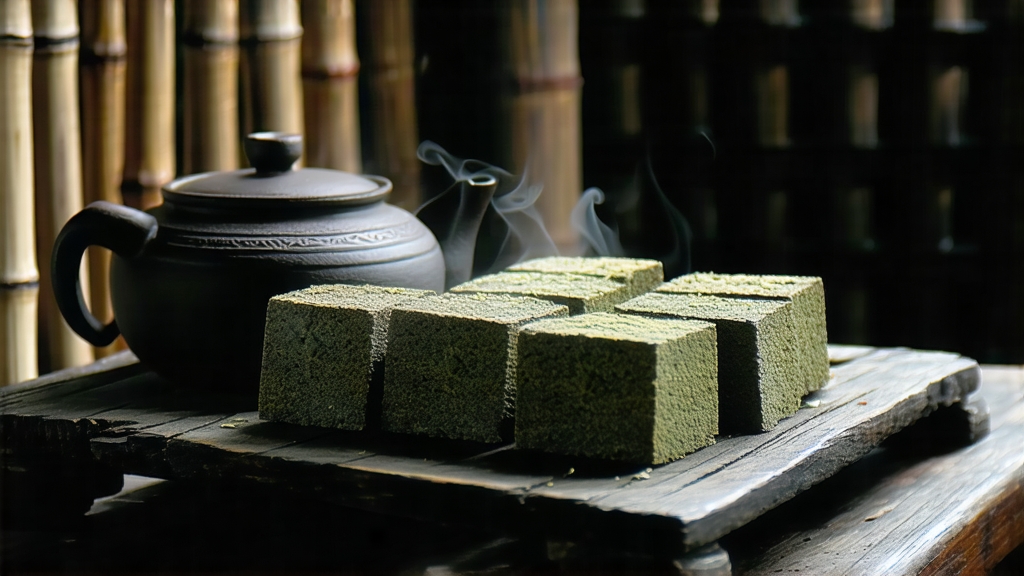
Tucked away in the humid, karst-veined mountains of southern China’s Guangxi Zhuang Autonomous Region, Liupao (literally “Six Forts”) tea has spent four centuries quietly perfecting the art of microbial alchemy. To most outsiders the word “dark tea” conjures images of Yunnan’s Pu-erh, yet connoisseurs inside China rank Liupao alongside that celebrity sibling, praising its deeper camphor-betel nuance and its almost medicinal sweetness. This article invites the global tea traveler to discover why Liupao was once the currency of overseas coolie ships, how its dual fermentations tame caffeine while nurturing rare molds, and how a single bamboo-lined storage room can turn rough leaf into velvet.
-
From Ming Militias to Maritime Trade
The name “Liupao” first appears in 1585 county records from Cangwu, where six Ming-dynasty garrisons guarded mountain passes. Soldiers bartered compressed tea bricks for rice; the pressed leaf traveled well and resisted the valley’s damp. By the late Qing, Liupao had migrated down the Xun River to the treaty port of Wuzhou, then outward to Hong Kong, Singapore and finally the tin mines of Kuala Lumpur. Indentured laborers prized the tea for settling stomachs soured by ship biscuit and malaria pills; European planters later bought it as a “coolie tonic,” unknowingly financing an underground cult of aging bamboo baskets in Penang’s warehouses. When the Communist government nationalized tea in 1953, Liupao’s export code “L-7101” became the first numbered dark-tea SKU of China Tea Corporation, cementing its bureaucratic immortality. -
Terroir: Rivers, Fog and Red Clay
Guangxi’s subtropical monsoon delivers 1,600 mm of rain annually, but the critical actor is the diurnal fog that forms when warm Xi Jiang valley air meets the cooler granite domes of the Dayao Mountains. The mist filters UV, forcing the tea bush (predominantly a local large-leaf Camellia sinensis var. sinensis f. pubilimba) to manufacture more amino acids and polyols. Soils are lateritic, rich in iron oxide and potassium; farmers joke that the earth already begins the “wet piling” before the leaf ever leaves the field. Elevation ranges from 200–600 m—low enough for microbial biodiversity yet high enough to slow growth, thickening cell walls that later feed the fungi. -
Harvest Calendar: One Leaf, Three Grades
Liupao is plucked in five seasonal windows, but only the spring and “Gu Yu” (late-April) picks become top-grade gongcha. Standard is one bud with the first three leaves; superior lots keep the bud and the first leaf, called “xiaomian” or “little face.” After picking, the leaf is carried in 5 kg bamboo creels to prevent bruising; any crushed edges oxidize prematurely and yield harsh “green notes” that even years of aging cannot mellow. -
Craft: The Double Dance of Water & Fire
Liupao’s processing follows the dark-tea trinity—kill-green, rolling, pile-fermentation, drying, steaming, compression—yet two steps are unique: the “mountain dew withering” and the “bamboo-basket secondary ferment.”
a. Mountain Dew Withering
Instead of indoor troughs, leaves are spread on bamboo mats set on granite outcrops from 10 p.m. to 6 a.m., absorbing dew laden with wild yeast. By dawn the leaf edges turn crimson, a sign of enzymatic edge-oxidation that later translates into the signature betel-nut aroma.
b. Wet-Pile Fermentation (Duīwò)
The piled leaf is sprayed with mineral water from the Xun River, then covered with jute sacks and banana leaves. Temperature probes are inserted; when the core hits 58 °C the pile is turned. This lasts 10–14 days—shorter than Fu brick but longer than ripe Pu-erh—allowing Eurotium cristatum to bloom into golden “flowers” without overwhelming the native Bacillus subtilis that produces the cooling, camphoraceous note.
c. Pine-Fire Drying
After piling, leaves are pan-fired at 180 °C for eight minutes, then dried on bamboo trays above a gentle pine ember pit. The smoke is not meant to flavor